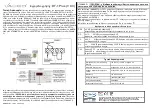
8
DMC490 Overview
Chapter 1 -
The DMC490 Microgrid Controller:
•
Controls and monitors a microgrid
•
Optimizes the dispatch of electrical generation, thermal generation, and energy storage to minimize
operating cost
Application Overview
The Microgrid Controller optimizes the dispatch of electrical generation, thermal generation, and energy
storage to minimize operating cost. It operates in a supervisory mode, issuing on/off and dispatch commands
every few minutes. The MGC works in a grid-connected or standalone microgrid.
Up to 32 electrical and heating resources are supported, including the following:
•
Renewable, such as wind turbines, hydro, solar panels
•
Dispatchable generators, such as diesel generators
•
Combined heat and power (CHP) generation, or cogeneration
•
Heating elements, such as boilers
•
Storage, specifically hydrogen-based and batteries
•
Utility grid connections
The block diagram of Figure 1 shows the microgrid approach. When the resources include Modbus server
functionality, the UR controllers are unnecessary. For example, when a wind turbine is added to the microgrid
and it has Modbus server capability, a UR controller is not needed for it.
Figure 1 Microgrid approach – Block Diagram
The storage can be short or long-term:
•
Short-term storage functions of the MGC help in step-load changes resulting from load-generation
variations or in transferring to an islanded microgrid.
•
Long-term storage from tens of minutes to several hours helps during peak demand periods and in
shifting power generation to environmentally-friendly renewable sources.
Summary of Contents for DMC490
Page 6: ......









































